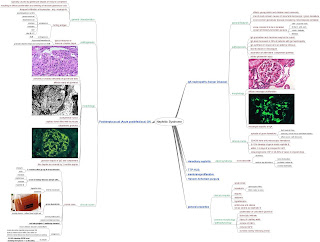I decided to save some time by learning only 2 of the main ones - post-infective, IgA nephropathy.
Nephritic Syndrome
- IgA nephropathy (berger Disease)
- general features
- affects young adults and children most commonlyone of most common causes of recurrent microscopic / gross hematuriamost common glomerular disease revealed by renal biopsies worldwidesome consider it to be a localized
variant of Henoch-Schonlein purpura- skin - purpuric rash
- GI tract - abd. pain
- Joints - Arthritis
- kidneys
- pathogenesis
- IgA production and clearance may be the culprit
- IgA level increased in 50% of patients with IgA nephropathy
- IgA synthesis in responce to an external stimulus
- lead to depots in mesangium
- actiavation of alternative complement pathway
- initiate glomerular injury
- morphology
- diffuse mesangial proliferation
- mesangial deposits of IgA
- clinical course
- episode of gross hematuria
- last several days
- subside, only to recur every few months
- often assoc. with loin pain
- 30-40% have only microscopic hematurea
- 5-10% develop a typical acute nephritic $.
- within 1-2 days of a nonspecific URTI
- slow progress to CRF in 25-50% of cases in 20years time.
- episode of gross hematuria
- general features
- Hereditary nephritis
- Alport syndrome
- associated with
- deafness
- various eye disorders
- lens dislocation
- posterior cataracts
- corneal dystrophy
- associated with
- Alport syndrome
- TTP-HUS
- membranoproliferative
- Henoch-Schonlein purpura
- Poststreptococcal (Acute postinfectious) GN
- general characteristics
- typically caused by glomerular depots of immune complexesresulting in diffuse proliferation and swelling of resident glomerular cellsfrequent infiltration of leukocytes - esp. neutrophilsinciting antigen
- exogenous
- poststreptococcal GN
- pneumococcal
- staphylococcal
- mumps
- measles
- VZV
- Hep B & C
- endogenous
- SLE
- exogenous
- pathogenesis
- typical features of
immune complex depot- hypocomplementemia
- granular depots of IgG and complent on GBM
- morphology
 uniformly increased cellularity of glomerular tuftsaffects nearly all glomeruli
uniformly increased cellularity of glomerular tuftsaffects nearly all glomeruli subepithelial humpscapillary lumen filled with leukocytecytoplasmic granules
subepithelial humpscapillary lumen filled with leukocytecytoplasmic granules granular depots of IgG and complementthis depots are cleared by 2 months approx
granular depots of IgG and complementthis depots are cleared by 2 months approx
- clinical course
- classic case
- 1-4 weeks after group A strep infection
- pharynx
- skin
- onset of kidney disease abrupt with...
- malaise
- slight fever
- nausea
- nephritic $
- mild to moderate
- hypertension
- azotemia
- gross hematuria
 smoky brown - rather than bright red
smoky brown - rather than bright red
- some proteinurea
- serum complement low
- anti-streptolysin O antibody elevated
- prognosis
- most children recover uneventfullysome develop rapidly progressive GN
due to severe injury with crescents or
chronic renal disaease due to secondary scarringin adults- 15-50% develop ESRD over
ensuing few years / 1-2 decades.
- 1-4 weeks after group A strep infection
- classic case
- general characteristics
- general properties
- clinical complex
- acute onsethematuria
- dysmorphic RBC
- RBC casts in urine
oliguriaazotemiahypertensionprotinurea and edema
not as severe as nephrotic $
common morphology
/ pathophysiology- proliferation of cells within glomeruli
- leukocytic infiltrate
- injury of capillary walls
- escape of RBCs
- reduced GFR
- ischemic kidney releasing rennin

No comments:
Post a Comment
hi. any kinds of comments are welcome! thank you...